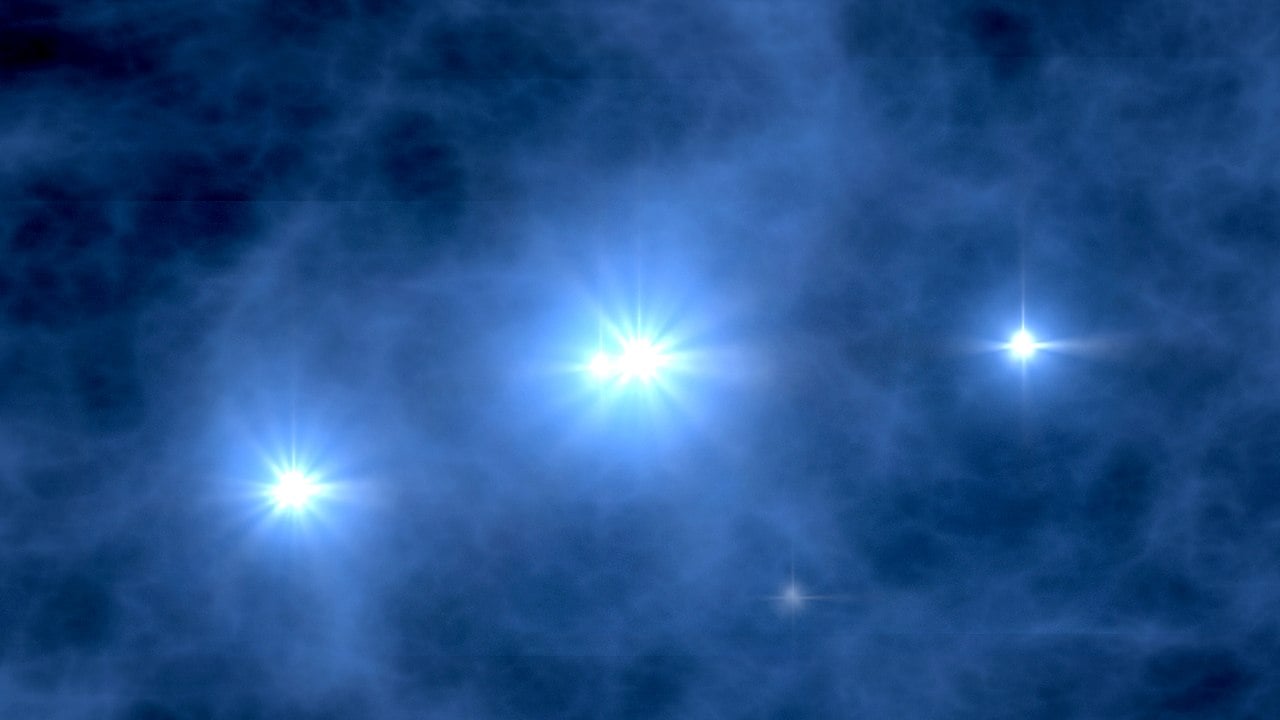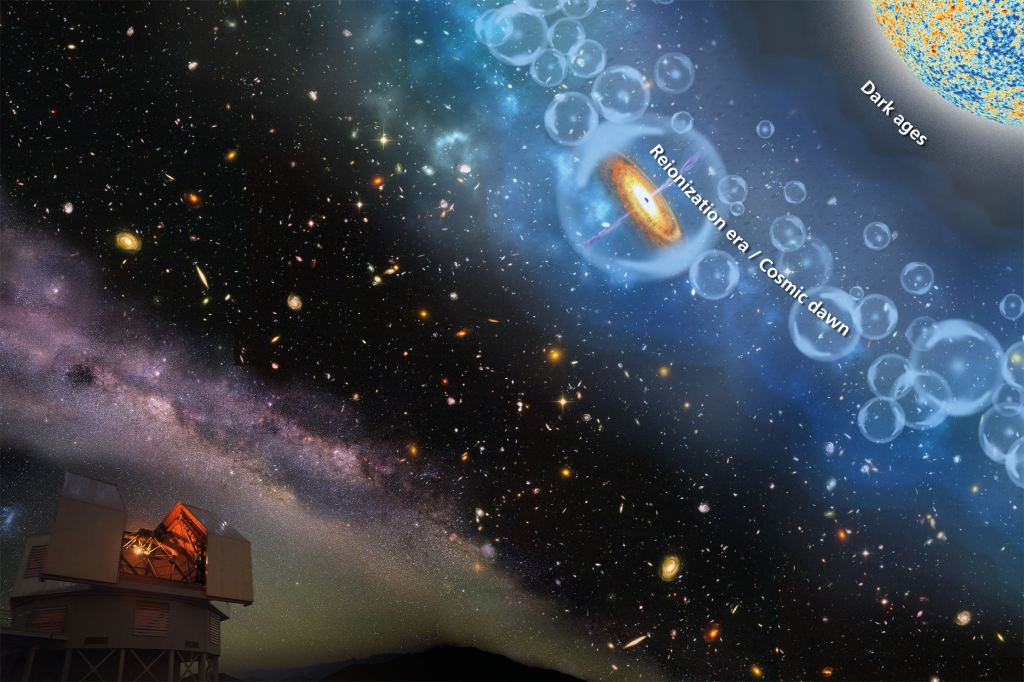We're all familiar with the famous opening of the TV show "The Big Bang Theory". It's a song that begins with the verse: "The whole Universe was in a hot dense state..." performed by the BareNakedLadies band. Turns out it's not just a cute line. The Ladies are right—it describes exactly what was going on with the Universe a long time ago. After the Big Bang, the cosmos was an intensely hot, dense, rapidly expanding soup of plasma. It was also in a cosmic "dark age" because there were no sources of light. It was just… well… dark. And hot.
What came next? Certainly, Earth didn't exist yet, nor did the autotrophs or Neanderthals or anything else mentioned in the song. All that was a long way away in time, space, and cosmic evolution. There wasn't even any light.
To get to light, the universe had to get through the Hot Soup period. That stretched out about 380,000 years. Throughout that time, the universe expanded and cooled, which led to its next state of existence. As it cooled, protons and electrons were able to combine and create vast amounts of neutral hydrogen. The Universe spent about 100 million years in this neutral-hydrogen-dominated period. Then (reminiscent of a line from the movie 2010), something wonderful happened. The first stars and galaxies began to form.
With stars you get heat—or, to be more scientifically correct—ionization. That happened when ultraviolet light from those hot, young massive stars tore apart the atoms of hydrogen and separate electrons from the protons. The good news is, that when you have ionization, you have light. And that, folks, is the executive summary of how the Universe lit up only a few hundred million years after the Big Bang. It entered what cosmologists call the "Epoch of Reionization"—the dawn of light in the Universe.
Quasar Light Reveals More about the Dawn
Astronomers know when this "Cosmic Dawn" began, but they still debate about when it ended. It's not just some academic exercise. Getting a precise "date" for the end of Cosmic Dawn is important. It can help them understand the first generations of stars that lit things up. And, once astronomers have more information about those early objects, a lot of other cosmological questions might get answered, too.
The search for that endpoint led Dr. Sarah Bosman and a group of astronomers at the Max Planck Institute for Astronomy in Heidelberg to look for clues in hydrogen. Not just any hydrogen, but that neutral version that existed way before the Cosmic Dawn. They thought they could find a way to observe a point in time where it was all ionized by early stars. If so, they'd know the end of Cosmic Dawn.
To find out, they sifted through the light streaming from 67 distant quasars. Some of the light they looked at streamed from 25 quasars observed during a project called the XQR-30 Survey. It used the European Southern Observatory's X-shooter spectrograph installed on the Very Large Telescope (VLT) in Chile. The X-shooter provides extremely high-resolution spectra of its targets. Spectra show the component wavelengths of light that a target emits or reflects. (Learn more about spectra and spectroscopy here.)
Traveling from Cosmic Dawn Through the Universe
The quasar light the X-shooter captured passed through hydrogen clouds at different distances from us. The light passed through ionized clouds as well as neutral clouds. The neutral hydrogen left a characteristic "fingerprint" on the spectrum of the quasar light at a wavelength of 121.6 nanometers. That's in the ultraviolet range of the electromagnetic spectrum. However, the light appears "shifted" to the red end of the spectrum due to the expansion of the universe. Astronomers say it's "redshifted" and the amount of redshift gives clues to the distance of objects emitting the light.
The distance data let Bosman and colleagues make a precise measurement of the end of Cosmic Dawn. It happened at a point 1.1 billion years after the Big Bang. "I am fascinated by the idea of the different phases which the Universe went through leading to the formation of the Sun and Earth. It is a great privilege to contribute a new small piece to our knowledge of cosmic history," she said. Bosman is the main author of a research article that appeared in Monthly Notices of the Royal Astronomical Society.
Modeling the Data to find Cosmic Dawn's End
The spectra Bosman's team studied presented some challenges since the quasar light passed through various regions in space on its way to Earth. That left a tangled set of fingerprints in the quasar spectra. For example, neutral hydrogen leaves a specific fingerprint. The same light also passed through the so-called "cosmic web" of matter that connects galaxies and galaxy clusters. It has both ionized and neutral hydrogen. That also imprinted the light.
So, astronomers had to untangle all the different fingerprints. To do that, they used a mathematical model that reproduces variations in light measured at a later time in the Universe, when intergalactic gas was already fully ionized. When they compared that model with their observations, they found a point where the 121.6-nanometer line of light they observed was shifted by a factor of 5.3 times. That corresponds to the cosmic age of 1.1 billion years (after the Big Bang). It's the latest period in cosmic history when neutral hydrogen gas must have been present in intergalactic space. After that, ultraviolet light from stars ionized the intergalactic hydrogen. That point in time point marks the end of Cosmic Dawn.
Next Steps
Now that a new benchmark "End of the Cosmic Dawn" date is set, what's next? More observations, of course. "This new dataset provides a crucial benchmark against which numerical simulations of the Universe's first billion years will be tested for years to come," said team member Frederick Davies. They will help characterize the ionizing sources, the very first generations of stars.
Knowing the end date of Cosmic Dawn provides tools for more numerical simulations of the period when stars first lit up the universe. And, it should open the door to exploring the whole Cosmic Dawn. "The most exciting future direction for our work is expanding it to even earlier times, toward the mid-point of the reionization process," Sarah Bosman stated. "Unfortunately, greater distances mean that those earlier quasars are significantly fainter. Therefore, the expanded collecting area of next-generation telescopes such as the ELT will be crucial."
For More Information
Hydrogen Reionization ends by z=5.3: Lyman-alpha Optical Depth Measured by the XQR-30 sample
 Universe Today
Universe Today


